I’ve spent a lot of my life living in city apartments, which was partly what led to my interest in soundproofing. There were so many times that I lay awake at night listening to traffic noise coming through my closed windows and, as I’m sure you know, it’s not very pleasant.
But this got me interested in the best window glass to reduce noise. Over the years, I’ve built up quite a collection of knowledge, and I figured it was time to bring it all together.
So, that’s what I’ll do in this article. Below, I cover the best window glass to reduce noise and all the factors you should consider when picking the most suitable option.
What is the Best Window Glass to Reduce Noise?
Unsurprisingly, the best option for reducing noise is acoustic glass. It’s a type of laminated glass that includes a layer of acoustically-insulated layer to absorb sound waves and reduce noise transmission.
Normal laminated glass contains a non-glass layer sandwiched between 2 panes. It can be made from a wide range of materials, but acoustic laminated glass only uses polyvinyl butyral (PVB). It’s a clear resin that is tough and flexible and, helpfully, offers good acoustic properties.
Acoustic glass is always laminated glass. As mentioned, it specifically uses PVB as its inner layer, although non-acoustic laminated glass can use a range of materials. To be as clear as possible, I’ll use the terms acoustic glass and laminated glass interchangeably in this article to refer to acoustic glass.
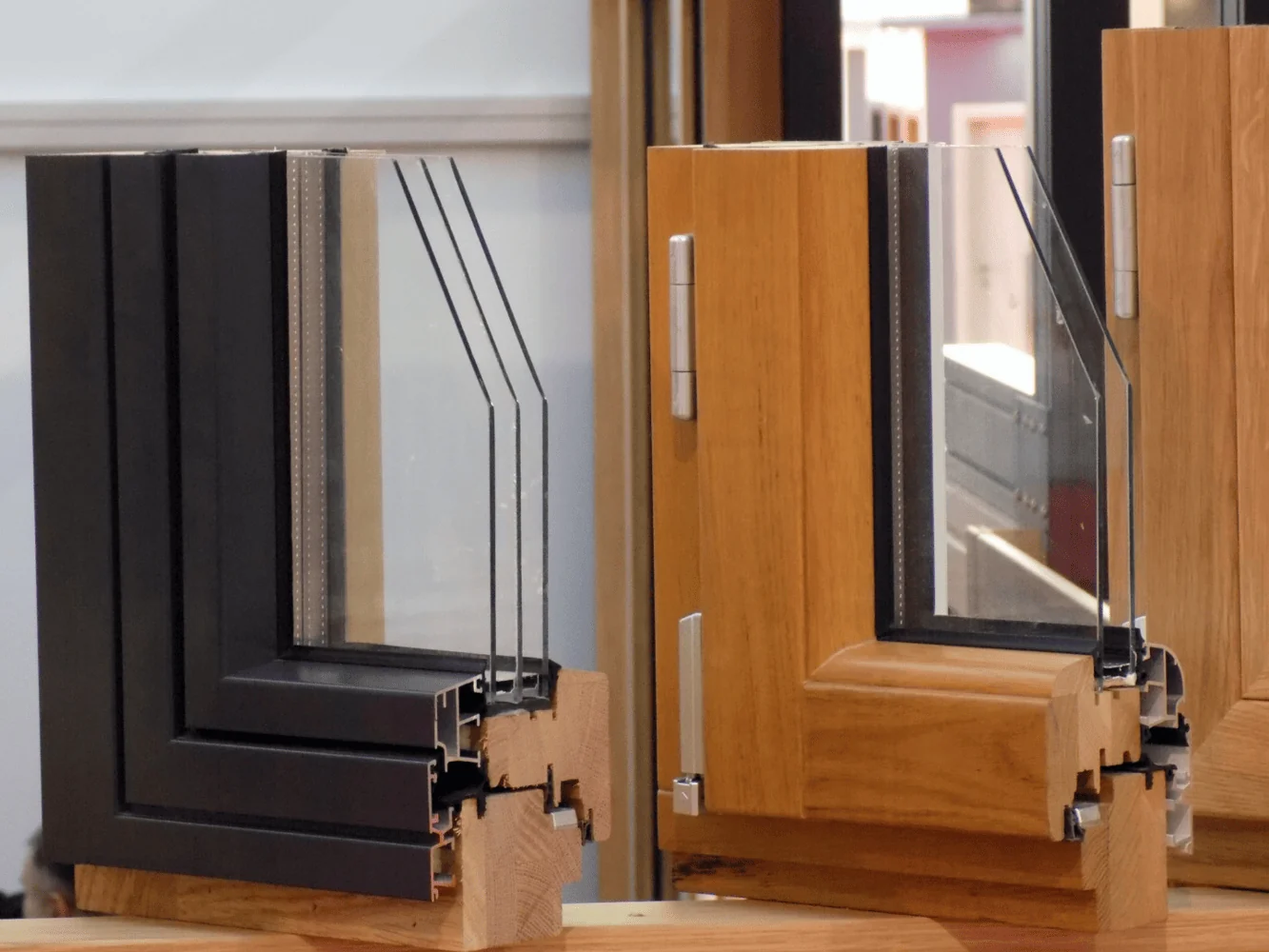
Measuring Sound Transmission Reduction
Saying a product is good at reducing sound is one thing, but it helps to have a clear metric for measuring this. Luckily, we have STC and OITC. Let’s briefly cover what they are.
STC
Sound transmission class is a measurement of how well a solid building material attenuates airborne noise. STC ratings are given as a whole number – higher is better. Materials are tested in a lab against frequencies ranging from 125 Hz to 4000 Hz, and the resulting curve is used to calculate the rating.
Some examples of STC reduction values are:
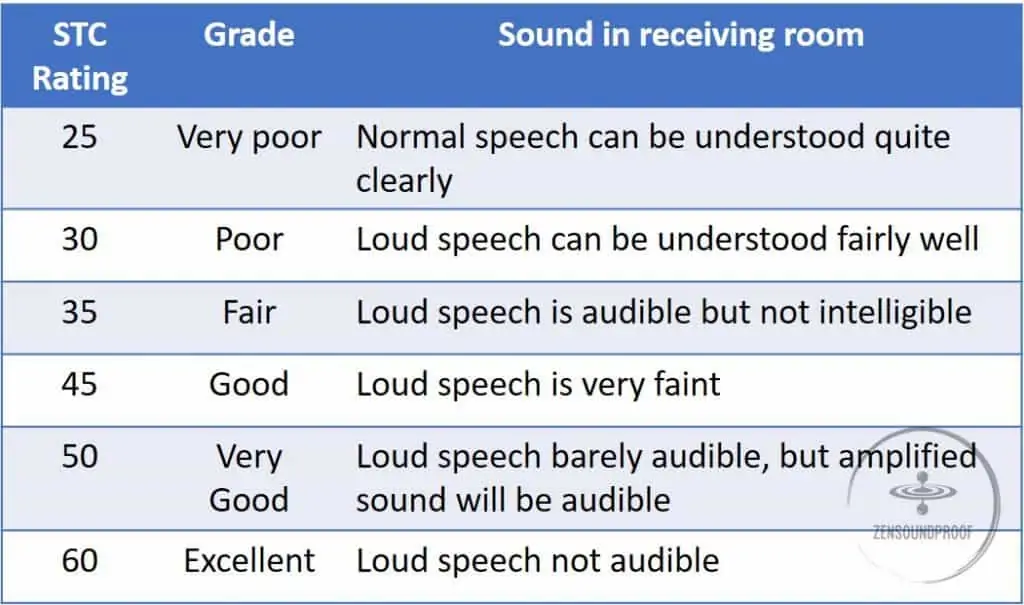
OITC
OITC stands for outdoor/indoor transmission class. It should be obvious what it measures from its name. Put simply, it measures noise reduction of outdoor noise in an indoor space, so focuses on external building materials. These might include brick, concrete and glass rather than drywall.
OITC is a helpful metric because it focuses on lower-frequency wavelengths that are typical in traffic noise, for example. Its top level is still 4000 Hz but it goes as low as 80 Hz, giving it a much wider range than the STC scale.
Because it’s designed for outdoor sounds, it’s arguably more helpful than STC ratings for window glass. However, it’s a less common metric, so we may have to rely on STC ratings in some instances.
Noise Reduction Ratings of Glass
The easiest way to understand what is the best window glass for noise is to look at their STC and OITC ratings in a table. Helpfully, General Glass has compared different types of glass for us:
| Glass Type | Total Thickness (in inches) | Air gap (in inches) | STC | OITC |
|---|---|---|---|---|
| Single-pane | ¼ | N/A | 31 | 29 |
| ½ | N/A | 36 | 33 | |
| Dual-pane Glass | 1 overall | 1/2 | 35 | 30 |
| 1-1/4 overall | 3/4 | 38 | 33 | |
| Triple-pane glass | 1-3/4 overall | ½ & ½ | 39 | 31 |
| 2-3/4 overall | ¾ & ¾ | 45 | 35 | |
| Single-Pane Acoustic Glass (i.e. Laminated Glass) | ¼ overall | N/A | 35 | 31 |
| 9/16 overall | N/A | 39 | 34 | |
| Dual-Pane Acoustic Glass (One pane is laminated) | 13/16 overall | 3/8 | 37 | 31 |
| 1-1/16 overall | 7/16 | 40 | 33 | |
| 1-7/16 overall | 3/4 | 44 | 36 |
At iso-thickness, choosing single-pane laminated glass over single-pane normal glass improves on average STC by 3 points (see example in purple in the table). The bottom line is that the addition of PVB makes a considerable difference to the performance of laminated glass.
However, the addition of a second pane of normal glass improves the STC performance compared to single-pane glass. This is primarily thanks to the air gap, which is a great acoustic insulator. As you can see, 1” dual-pane glass has the same STC rating as a single pane of acoustic glass.
The best for its size is dual-pane acoustic glass, as this combines an air gap and PVB for superior performance.
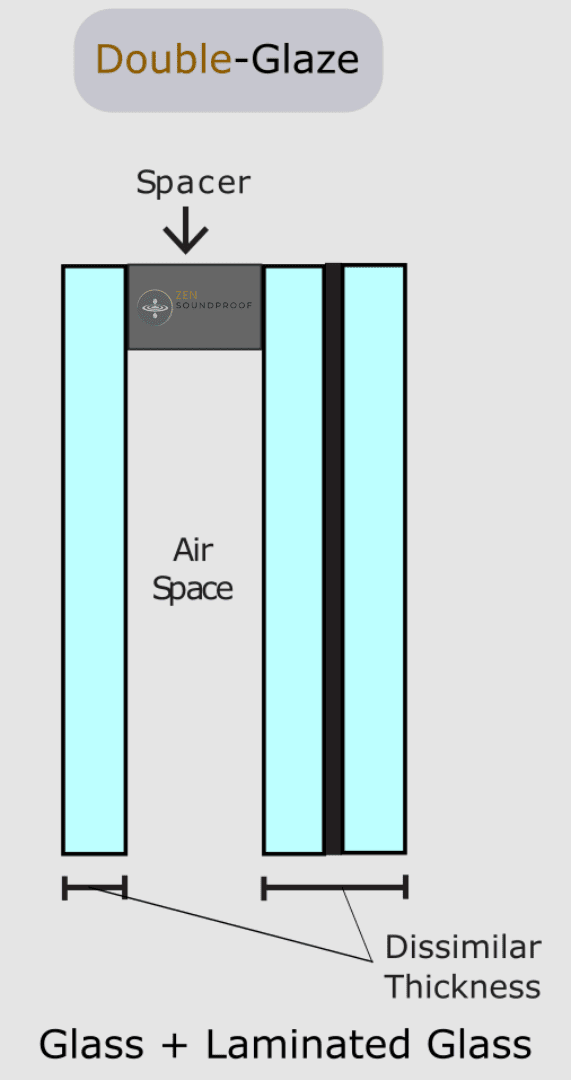
Similarly, triple-glazed glass performs as well as dual-pane acoustic glass, although it’s noticeably thicker.
In the next section, we’ll go through how thickness and air gap help a window to reduce noise.
What Factors Influence Noise Reduction in Window Glass?
When considering how glass panes perform in terms of noise reduction, we must consider a few factors:
Thickness
Thickness of glass is an obvious metric for noise performance. Thicker glass means more mass (albeit marginally so), which means more sound blocking.
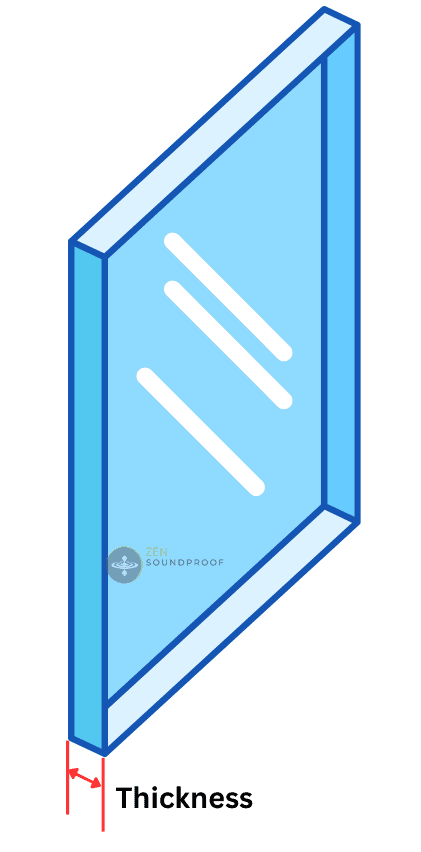
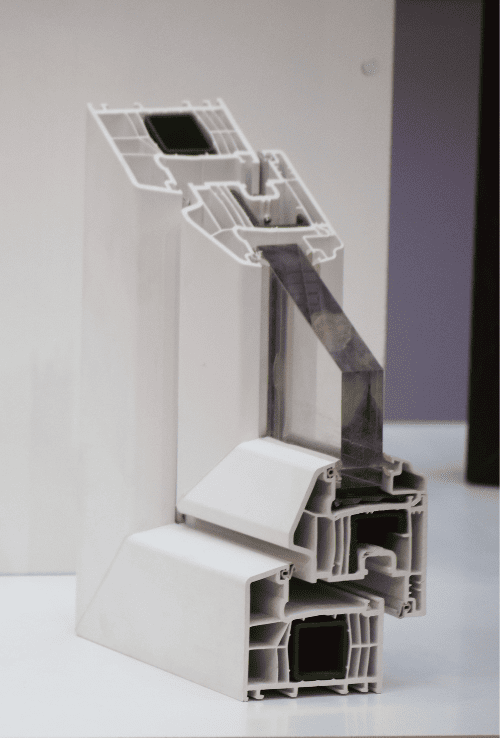
Helpfully, glass panes come in fairly standard thicknesses, although availability may vary. Some examples of common glass thickness are:
| Typical Thickness (inches) | |
| Single Glazing (Non-laminated) | Acoustic Glass (Laminated) |
| 3/32 | 1/4 |
| 5/32 | 5/16 |
| 1/8 | 3/8 |
| 1/2 | |
| 9/16 | |
Single pane windows don’t usually get too thick, although half-inch thick single pane glass isn’t unheard of. On the other hand, laminated, double pane windows and triple pane windows are usually thicker as a unit because of the combination of numerous panes and the air gap.
Perhaps what’s more important here is that the STC table above illustrates the impact that thickness actually has on performance regarding noise pollution.
| Glass Type | Total Thickness (in inches) | Air gap (in inches) | STC | OITC |
|---|---|---|---|---|
| Single-pane | ¼ | N/A | 31 | 29 |
| ½ | N/A | 36 | 33 |
With single pane windows, the STC rating is 31 at ¼” and 36 at ½”. There’s an STC increase of 5 points when we double the thickness, which can be a noticeable difference when combined with other noise reduction properties.
Air Gap and Multi-Panes
Double- and triple-glazed windows have an air gap between the panes, which is usually filled with argon gas. This is a poorer conductor of heat than normal air but has no impact on the glass’s acoustic properties (compared to normal air, that is).
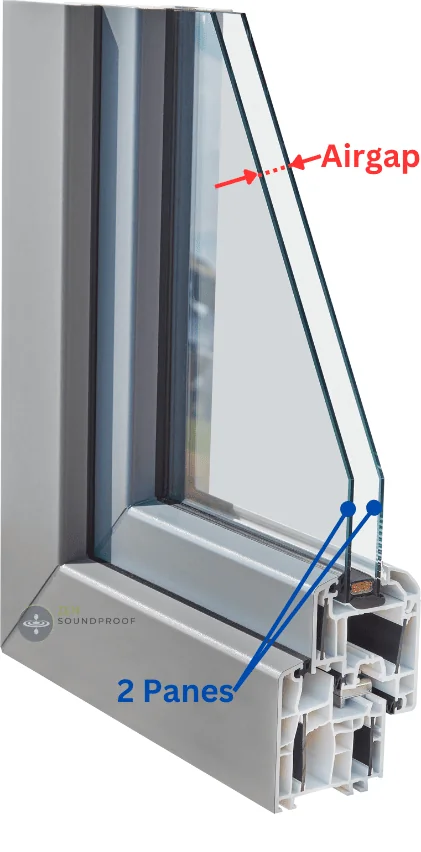
The air gap itself, though, helps reduce sound transmission. Air is a poor conductor of sound, and a larger air gap will provide more acoustic insulation than a smaller one.
Air gaps can range from 3/8” to 3/4″ depending on the overall setup and number of panes.
| Glass Type | Total Thickness (in inches) | Air gap (in inches) | STC | OITC |
|---|---|---|---|---|
| Dual-pane Glass | 1 overall | 1/2 | 35 | 30 |
| 1-1/4 overall | 3/4 | 38 | 33 |
Let’s return to the STC figure table above. In a double pane window, the table has air gaps of ½” and ¾”. The glass thickness is the same for both, but the STC rating goes up by 3 points.
Similarly, in the triple glazed unit, the two air gaps go up by ¼” each. This results in an STC increase of 6 points.
Triple-glazing might suggest that it has more air gaps and more mass, and thus would perform better from an acoustic standpoint, that’s not totally true. Read on to find why.
Frame Material
The window frame’s material and seal have an impact on sound transmission. Sound waves will look for the path of least resistance, and this can often be the rigid framing material surrounding the window.
Wood is probably the best material for a window frame, followed by vinyl and UPVC. Metal is arguably the worst.
However, the more important part is the way the frame is sealed into the wall. For this, latex caulk is better than silicone, as it adds a level of sound dampening to reduce transmission between the frame and wall.
Installation Quality
Unsurprisingly, a more poorly installed window is more likely to have air gaps, cracks and misalignments. All these factors can increase sound transmission through the window and frame, rendering soundproof glass essentially obsolete.
What Do I Need to Know About Acoustic Laminated Glazing Before Buying?
So, I’ve covered the aspects of choosing the best insulated glass unit in terms of performance, but what else should you know? Well, other factors worth considering are:
Trickle Vents vs. Acoustic Vents
Most modern windows will have trickle vents, which help prevent moisture buildup and improve ventilation. However, they let noise through. The only real alternative is an acoustic trickle vent, which you should be able to fit yourself if needed.
Here’s an example of an acoustic trickle vent, and this video on how to replace a trickle vent covers the process. Sure, they’re a bit uglier than a normal vent but they’re a necessary addition if you want to reduce sound transmission.
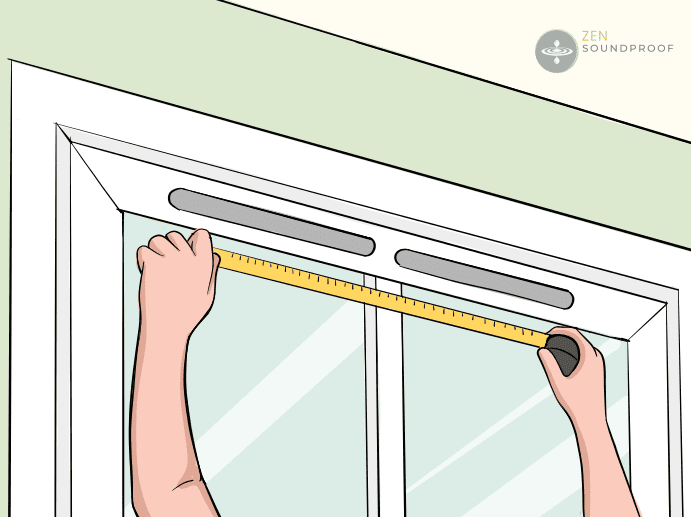
Space-to-Performance Benefits
Acoustic glazing has superior noise-reduction properties than triple-glazing. This is because the addition of the PVB layer is better than an extra layer of glass and another air gap.
This is especially true of low-frequency sounds associated with external noises like traffic and airplanes. Of course, the addition of an air gap alongside laminated acoustic glass (especially 2 panes of different thicknesses) is the gold standard of acoustic and thermal insulation.
Additional Benefits
Laminated glass offers several additional benefits on top of acoustic performance. These include:
- UV protection. The PVB layer provides additional UV resistance to prevent the glass from fading and protect your furniture from bleaching.
- Safety. The main reason for a PVB layer is to prevent glass from shattering – it’s typically used as safety glass. A laminated outer pane therefore means it’s harder for someone to break your window altogether.
- Space-saving. Laminated glass will take up less room (generally speaking) than double-glazing. However, this does sacrifice thermal insulation.
Potential Downsides
Going for only a single pane of laminated glass would be detrimental to your thermal insulation. The air gap in double glazed windows (or triple glazed) is really the only option when it comes to heat insulation.
Also, laminated glass is more expensive than ordinary glass. Of course, if you’re serious about reducing noise transmission, this is a sacrifice you’ll have to make.
Where Can You Get Window Glass to Reduce Noise?
Soundproof windows are a slightly more specialist product than normal glass. However, you shouldn’t need to do much searching for a decent product.
One example is Pilkington. Its website has a handy calculator to work out transmission loss, which you can use to test glass thickness and pane spacing. This should help you to figure out the best setup for your needs.
Another website is Saint Gobain. It has a good rundown of factors to consider when choosing acoustic glass, so it’s worth checking out. That said, there’ll be loads of websites for your country, and you should have a hunt around using the tips I’ve given above.
What is the Best Window Glass for Soundproofing?
So, to summarize, what’s the best glass for noise reduction windows?
The best setup for reducing noise transmission is acoustic glazing + air gap + acoustic glazing. For the best performance, use 2 panes of different thicknesses for different resonant frequencies. Also, throw in an acoustic trickle vent, wood or vinyl frame, and plenty of acoustic caulk.
If your budget or time doesn’t cover this setup, the next best thing is a double-glazing configuration of acoustic glazing and standard glass.
Finally, if you don’t have room for all that, a single pane of acoustic glass will be better than normal width double glazing. Acoustic glass has an Rw (transmission loss) of 35dB compared to 30dB of double glazing consisting of 2 panes of 5/32” glass. However, thermal insulation will suffer.
And that just about does it. Have you ever worked with acoustic glass? If so, do you have any insights you’d like to share? Drop them below!
